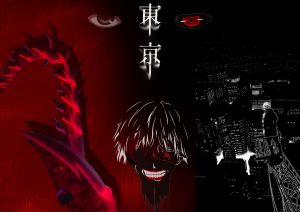Blurring the Lines of Identities:
Tokyo Ghoul and Equality
by Selis Yıldız Şen

Sui Ishida’s Tokyo Ghoul (2014) is a work of Japanese manga literature and anime that is not only centered around the experience of a single side in struggle with the other opposite, but also a reflection of the perspective of both sides in such a struggle. Moreover, it actually focuses on the struggle itself rather than favoring one side over the other. The struggle of existence between humans and the “ghouls”, who constitute the category of the non-human in the series, raises all kinds of question as to the etymon which generates the dynamics between the two sides to the extent of enmity and divergence. The unfolding of the events in the narrative does not, however, lead to a fixed and resolute answer to the question as to which side is the right one. On the contrary, the more the narrative unfolds, the blurrier a possible answer to this question gets.
Having said that, Tokyo Ghoul is an exemplary work of fiction for expressing, both conventionally and unconventionally, certain fears and anxieties that are related to the interactions between the human and non-human. The fact that the story revolves around the struggle between human and non-human is, in many ways, a conventional trope of narrative. However, the way Sui Ishida’s narrative represents this struggle by blurring the lines between any possible answer to the question as to which side is the villain and which side is the righteous one may be considered as notably unconventional. Moreover, even though there is a certain wildness and cruelty that is attributed to the life of a ghoul, the communal structure and way of living of the ghouls and the way they form familial and friendly attachments with other fellow ghouls is quite significant and similar to the ways of humanity. Besides, there is a whole corporal organization concerned with the mission of hunting ghouls (including child ghouls and women ghouls who are mothers or sisters, etc.) which is directed by humans and in many ways, not so different than the wild and cruel life of a ghoul. These are, in many ways, additions to the unconventional touches in the wholesome portrayal of the seemingly different and distinct forms of life within the narrative of Tokyo Ghoul.
Ken Kaneki, the protagonist of the narrative, may be considered a suffering messenger, a bridge between the two painfully and tragically intertwined worlds of humans and ghouls. Kaneki becomes the ground of the possibility and hope for creating any kind of understanding between the community of humans and of non-humans.
The presentation of the forms of solidarity which attach the ghouls to each other and the humans to each other functions as a way to blur the line between the humans and ghouls, between the human and non-human. This kind of a blurring undoubtedly creates a certain understanding not merely in favor of the human but also of the non-human, which hopefully may result in an equal approach towards those who stand on the margins of the society.

